by Texas Homesteader ~
Chickens waste a LOT of feed! So we made an Inexpensive PVC chicken feeder that’s SUPPOSED to cut down on wasted feed. But did it work as advertised? Check it out & see…
Chickens Waste A LOT Of Feed!
One thing I noticed when we first bought chickens several years ago was how wasteful they were. They use their beaks to sweep their feed from side to side.
That ends up slinging much of their food out of the feeder. And all that feed is wasted!
The first time I cleaned out the coop I started to sweep out the hay bedding and found it was heavy with wasted feed & grain. I was so frustrated.
Dang girls, were you raised in a barn? (Oh, yeah right, strike that…)
Still, I needed a way to reduce the waste the chickens made with their feed. It does neither them nor me any good to have purchased feed dumped on the ground and tread upon or just attract vermin. But how…
I Hated The Waste Of All That Chicken Feed
As I watched them once again sweep their beaks across their feed dish, scattering that expensive feed out and upon the ground, I sighed.
Hey, we’re feeding these girls organic layer pellets, and that’s not chicken feed ya know…
Oh, maybe it *is* chicken feed…
But it’s too expensive to be wasteful & sweep it out of the coop & onto the ground! There’s got to be a way to keep them from wasting so much.
How To Reduce Waste When Feeding Chickens
So I experimented with various ways to make our own lower-waste chicken feeder. I first used a plastic canister and a metal pan lid. It was easy to fill and sturdy.
But although it did help reduce the chicken-feed waste, way too much was still being wasted.
Meeting Another Chicken-Raising Homesteader
But then at a Mother Earth News Fair I attended one year I was able to share a table with another Texas girl at a chicken seminar we attended.
She’d mentioned that she too was frustrated with the feed her chickens wasted. So she and her hubs built a PVC chicken feeder. She said her feed bill was cut in half.
Chicken Feed Bill Cut In HALF!!?? Well color me interested!
What Size PVC For A Chicken Feeder?
RancherMan & I decided on a 3″ diameter feeder. Want to know the technical & scientific reason why we chose 3-inch?
Well it was because we already had some PVC that size in the shed! LOL #UseWhatchaGot, y’all. That’s always been my battle cry.
Here’s a list of what we used to assemble our own PVC chicken feeder:
PVC Chicken Feeder Materials:
(Note: All PVC pipe materials below are 3″ in diameter)
-
-
- (1) 5-ft length of PVC pipe to hold chicken feed
- (1) PVC Wye to make base for feeding tube
- (1) 5″ length of PVC pipe to raise feeding tube off the ground
- (1) 8″ length PVC pipe for feeding tube
- (3) PVC caps – one top, one bottom, one to close the feeding tube at night.
-
So first RancherMan retrieved a 5-foot long piece of the 3″ PVC pipe we had stored away from a previous project. Then he added a matching 3″ PVC Wye. This will allow a feeding tube for the chickens.
To the wye he added the 5″ length to the bottom to make a foot of sorts to hold the feeding tube off the ground. Finally he added the 8″ length of PVC to serve as the feeding tube for the chickens.
(NOTE: We tried a 5″ feeding tube length first but the chickens were still able to sling out food. For us an 8″ feeding tube solved that problem, the pellets just fall back into the feeder)
He put this feeder together in minutes and we strapped it to a t-post in the chicken run to make sure it stayed upright.
Do You Need Caps For A PVC Chicken Feeder?
There are 3 PVC caps to finish off our PVC chicken feeder:
One cap was attached to the bottom of the wye so no feed will touch the ground.
Another cap was applied on top where we fill the feeder. It keeps out rain so our chicken feed doesn’t get wet & moldy.
The last cap goes on the end of the feeding tube to close it up when the girls are put up for the night. I don’t want rats or mice finding this all-you-can-eat buffet to be open all night!
Easy Backyard Chicken Feeding Routine
Now in the morning when I let the girls out of their coop for the day I remove the cap on the feeding tube. They enjoy their own little buffet in the chicken yard.
I usually replace the cap about mid-day. I want them hungrier to eat a healthier free-ranging diet rich with grass & bugs to go along with their organic feed.
By closing up their free-choice feeder mid day they’ve built up a healthy appetite once they’re released to free range. I love that they track down and eat those grasshoppers destined to ruin my garden. And let me tell ya, those girls LOVE their job!
I double check to make sure the cap has been firmly placed over the feeding tube when I lock the chickens up at night. That keeps other wildlife such as mice or rats from finding the mother lode and thinking it’s an all-you-can-eat buffet served especially for them.
I hate when mice use the buffet line – they’re terrible tippers. 😉
My friend was absolutely right – this little feeder really does reduce (or even eliminate) wasted feed. I love it.
It’s taken only a very few dollars and a few minutes time to make it ourselves with most PVC materials we already had. And the amount of wasted chicken food has plummeted.
That’s an all around financial/environmental win!
(Note: If wild birds start enjoying your chicken feeder as much as your chickens do, you can use this Homestead Hack to keep birds away from your feeder!)
That swinging multi-colored CD has been 100% successful in keeping the wild birds out of our purchased chicken feed. SCORE!
~TxH~
Chicken-Care Posts
- How To Teach Free-Range Chickens To Come HOME
- Keeping Chickens Safe From Predators: Automatic Coop Door
- How Much Does It Cost To Raise Your Own Chickens?
- Cheaper Ways To Raise Chickens Using What You Have
- Breaking The Broody Hen
- What Color Eggs Will My Chickens Lay?
- MYO Low-Waste Chicken Feeder
- Repurposed Coffee Can Chicken Feeder
- Keeping Wild Birds Away From Your Chicken Feeder
- Nutritional Difference Of Free-Range Eggs
- How To Protect Seedlings From Free-Range Hens
- Keeping Our Chickens Mite Free
- How To Get Free Chicken Food
All Posts About Chickens
C’mon by & sit a spell! Come hang out at our Facebook Page. It’s like sitting in a front porch rocker with a glass of cold iced tea – lots of good folks sharing! You can also follow along on Pinterest, Twitter or Instagram.
If you’d like to receive an email each time a new blog post goes live it’s EASY to
Subscribe to our blog!

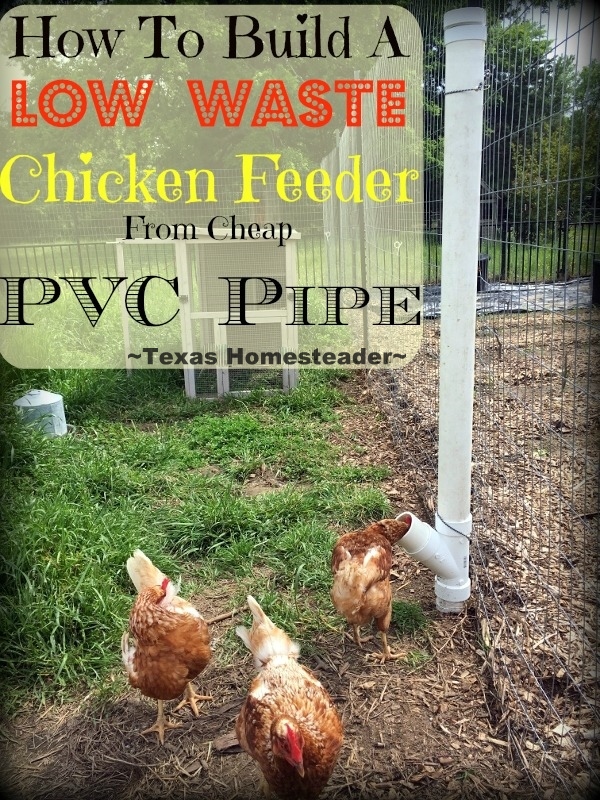
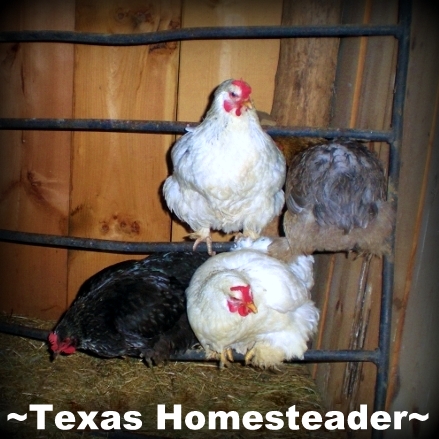
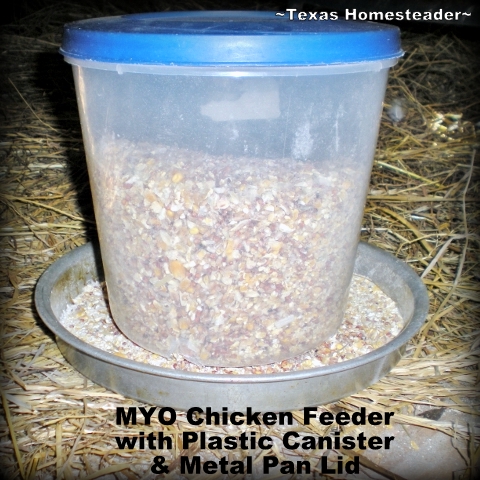

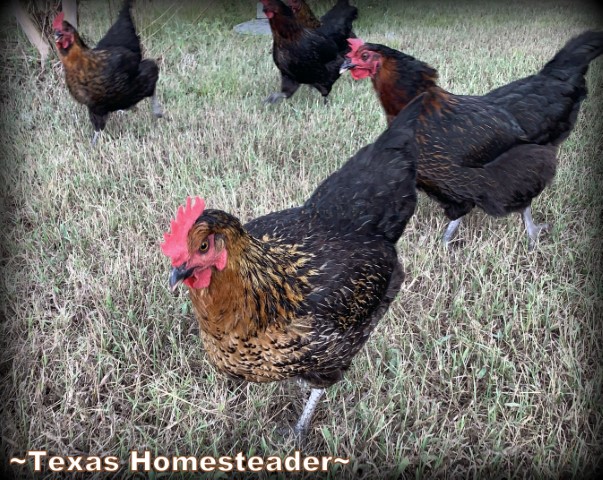
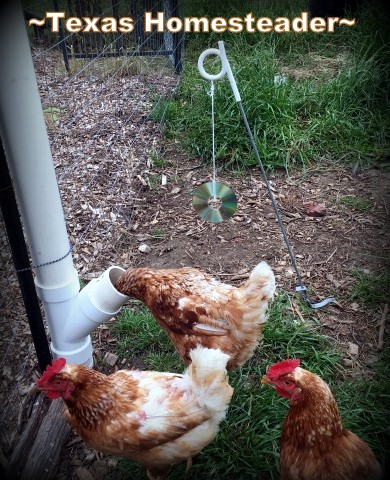
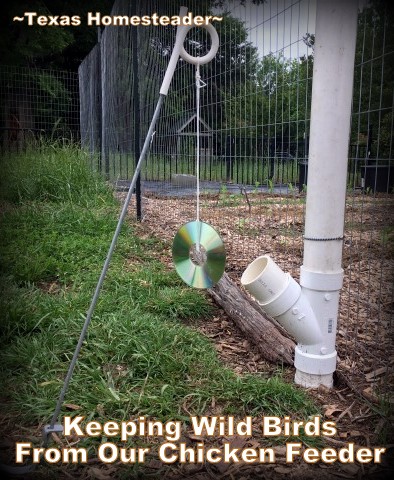


No chickens here to use this great idea, but I pinned it to my creative and crafty friends board in hopes you can get some more traffic from it. Nice post ~TxH~
I appreciate the share, Greg. Spilled & wasted feed not only costs money, but attracts undesirables to your chicken area. This feeder really has been great for us and it cost so little both in money as well as time to put together. ~TxH~
Good morning, Tammy! Planning ahead to add chickens to my yard next year…how do you manage these in rainy or snowy weather? Just put the lid on? And what’s your scenario for filling? Pour in right from bag, or do you have a more efficient way? (I’m pretty clumsy!) thanks for taking time to write every day!
Hey Brenda, you’re gonna love chickens! When we first started raising chickens I was dismayed over how wasteful they could be with their feed. But after making and using this PVC chicken feeder our feed waste has gone waaaaaaay down (near zero I daresay). When it’s empty I bring it into the garage & use a funnel on the top of the feeder and a coffee can to scoop the feed into the funnel. Then carry it back to the chicken run and strap it back to the fence.
But we’re in a different situation than most I guess when it comes to our hens. We only raise chickens from spring to late fall, selling them as layers in the fall and buying new pullets in the spring. This is because during the winter predator pressure is too great and we’ve just lost too many hens over the years, especially in a modified free-range situation. So although we don’t have hens during the cold weather I do struggle with the rainy weather. Some have said they keep these feeders inside the coop but that doesn’t apply in our setup. I’m dreaming of some sort of tiny awning-like cover or something but I haven’t solved that yet. If it’s raining when I let them out of their coop I’ll toss feed in a little metal bowl that I keep in the floor of their coop. I do that again when I go to collect eggs if it’s still raining but if not I’ll open the PVC feeder then. ~TxH~
We have something similiar but ours still seem to waste. I think the end of ours isn’t quite as upright as yours.
Our first attempt saw them slinging too much feed out of the feeder as well Charlotte, but we extended the piece coming from the “Y” to about 6″ and it brought it up high enough that any feed they slung fell back into the feeder. You might try that & see if it helps. Also the feed would get slightly wet when it rained so after we were sure we had it made the way we wanted it, RancherMan took PVC glue and glued all the parts together and we haven’t had any trouble with moisture since. I do love this feeder, since we only have two hens we only fill it once every few weeks or so. Our feed waste has gone to almost ZERO! ~TxH~
We have about 25 ladies… how many chickens do you have eating from this feeder? Love the idea, just wondering if we’d need a few to keep them all happy…
We’ve opted to only have enough girls for the egg requirements for RancherMan & me, so we have three eating from this one feeder, Katie. I’ve seen setups where they’ve lined up several of these feeders when they’ve had a larger flock. ~TxH~
I would like some info on your organic chicken feed. Where do you get, how much is it comparatively? Also, how in the world do you keep the cotton-picken mice out of your feed? They burrow up from the feeding end and eat at the top of the feeder, no matter what kind we have tried. grrr I worry about the contamination from the little buggers! Thanks for everything your do!
We got our organic feed from Tractor Supply, Carol. When we bring the feed home we store it in our metal shed, so far mice have not been an issue at all in there even though we’ve kept various feeds in there for years. We bring one bag at a time into our garage and empty it into a large cooler. Although we do have mice from time to time in the garage, they’ve never bothered our chicken feed in the coolers. (we keep our dry dog food in coolers as well) Maybe the insulation keeps the food aroma down? I don’t know, but it certainly works for us. Then we use the feed in those coolers to keep the PVC chicken feeder filled. We have a cap on the foot of the feeder so I don’t think mice can burrow through. I also place another cap on the feeding portion every night so that the mice don’t think it’s an all-you-can-eat buffet after dark. So far we haven’t had a problem with mice at the feeder. ~TxH~
You always have super creative ideas! Thanks for sharing!
This is an ingenious idea that I would have never thought of. I passed on this information to my mother-in-law.
Thank you for sharing this with us on the #HomeMattersParty. We hope to see you again on Friday when we open our doors at 12 AM EST.
Great idea! We are always looking for ways to cut costs on feed! Thank you for sharing this on the Art of Home-Making Mondays at Strangers & Pilgrims on Earth! 🙂
I used to have chickens and I had a terrible time with sparrows eating the feed. They even WENT INTO THE CHICKEN HOUSE!!!
With only one hen able to eat at a time, do you ever have them fighting to get their turn? Hubs made me a feeder out of a kitty litter jug that he had put a J-shaped piece of PVC pipe into the side and they pecked on each other terribly. Plus it didn’t stop the sparrows, they’d just fly into the pipe and eat, plus poop inside it as they left. SHEESH! I got tired of being responsible for keeping every sparrow in the county fat, so I finally just gave up on having chickens. It was fun while it lasted, though, and I loved those fresh eggs.
OMGoodness Ilene, I know what you mean with the sparrows. You’ve gonna LOVE tomorrow’s Homestead Hack, it deals with how to keep those dang sparrows away from the chicken feeder and out at their own feeder where they belong! Be sure to check back tomorrow. ~TxH~
Thanks for sharing. We are hoping to begin our chicken venture soon. It’s nice to be able to learn the lessons from other more experienced farmers.
Carol
When we started with our chickens we bought everything we thought we needed – galvanized waterers and feeders, another HUGE galvanized feeder so we could keep ’em fed in our absence if we took a little trip, etc. Oh if I had it all to do again we could save so much money! LOL ~TxH~
By the way, passing along the link to this to friends I know that raise chickens :}
Awesome Colleen, thanks. It really has made a tremendous difference in feed waste for us. ~TxH~
Clever idea ladies.
Boy, them chickens are picky eaters. About as bad as the birds are when we fill the bird feeders but at least there are birds that that will eat the seed which gets chucked on the ground for the ground feeder feathered friends
That’s what I was thinking too Colleen. I don’t so much mind it in the bird feeders, the ground feeders make good use out of it and not much at all is actually wasted. But dang I hate to plunk down the coin for specialty feed for keeping our chickens healthy & laying well just to have it tossed on the ground. ~TxH~
YAY!! I’m glad it’s working for you too! I think it’s cool when people can use an idea, but also modify to be a perfect fit for their situation. Our feeders are still working great for us and now we’re adding one for their oyster shell. Thanks for the shout out my awesome friend!
Whaaaa…. Another one for oyster shell? what a great idea, I may have to dive into that for sure! ~TxH~